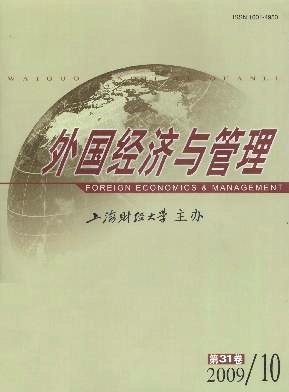权力循环视角下的公司治理研究综述
外国经济与管理 2009 年 第 31 卷第 10 期, 页码:54 - 58
摘要
参考文献
摘要
权力循环理论将权力动态观引入了公司治理研究领域。本文在文献梳理的基础上,首先介绍了静态权力观和动态权力观,然后论述了权力循环理论中的两个重要机制——废退机制和争夺机制,并运用权力循环理论分析了CEO权力变化的过程和原因,并阐述了董事会治理机制、CEO继任以及内部董事等问题,为公司治理研究提供了一个新视角。
[1]Occasio,W.Political dynamics and the circulation of power:CEO succession in US industrial corporations,1960-1990[J].Administra-tive Science Quarterly,1994,39(2):285-312.
[2]Shen,W,and Cannella,A.Power dynamics within top management and their i mpacts on CEO dismissal followed by inside succession[J].Academy of Management Journal,2002,45(8):1 195-1 206.
[3]Miller,D.Stale inthe saddle:CEOtenure andthe match between organization and environment[J].Management Science,1991,37(1):34-52.
[4]Hambrick,D C,and Fukutomi,G S.The seasons of a CEO’s tenure[J].Academy of Management Review,1991,16(6):719-742.
[5]Ocasio,W,and Ki m,H.The circulation of corporate control:Selection of functional backgrounds of new CEOsinlarge of US manufac-turing firms,1981-1992[J].Administrative Science Quarterly,1999,44(4):532-562.
[6]Fligstein,N.Markets as politics:Apolitical-cultural approach to market institutions[J].American Socio-logical Review,1996,61(6):656-673.
[7]Shen,W.The dynamics of the CEO-board relationship:An evolutionary perspective[J].Academy of Management Review,2003,28(3):466-476.
[8]Harris,D,and Helfat,C E.CEOduality,succession,capabilities and agent theory:Commentary and research agenda[J].Strategic Man-agement Review,1998,19(9):901-1 004.
[9]Combs,J,Ketchen,Jr D,Perryman,A,and Donahue,M.The moderating effect of CEO power on the board composition-firmperform-ance relationship[J].Journal of Management Studies,2007,44(8):1 299-1 323.
[10]Boeker,W,and Goodstein,J.Performance and successor choice:The moderating effects of government and ownership[J].Academy ofManagement Journal,1993,36(2):172-186.
[11]Henderson,A D,and Fredrickson,J W.Top management teamcoordination needs and the CEO pay gap:Acompetitive test of eco-nomic and behavioral views[J].Academy of Management Journal,2001,44(1):96-117.
[12]Berger,B K.Power over,power with,and power to relations:Critical reflections on public relations,the dominant coalition,andactivism[J].Journal of Public Relations Research,2005,17(1),5-21.
[13]Cannella,A A,and Shen,W.So close and yet sofar:Promotion versus exit for CEOheirs apparent[J].Academy of Management Jour-nal,2001,44(2):252-270.
[14]Pitcher,P,Chrei m,S,and Kisfavli,V.CEO succession research:Methodological bridges over troubled waters[J].Strategic Manage-ment Journal,2000,45(9):1 172-1 182.
[15]Weisbach,J B.Outside directors and CEOturnover[J].Journal of Financial Economics,1988,19(4):431-460.
[16]Zajac,E J,and Westphal,J D.Who shall succeed?How CEO/board preferences and power affect the choice of new CEOs[J].Acade-my of Management Journal,1996,39(1):64-90.
[17]Dunn,P.The i mpact of insider power on fraudulent financial reporting[J].Journal of Management,2004,30(3):397-412.
[18]Chowdhury,D,and Wang,E.Institutional activismtypes and CEO compensation:Ati me-series analysis of large Canadian corpora-tions[J].Journal of Management,2009,35(1):5-36.
[2]Shen,W,and Cannella,A.Power dynamics within top management and their i mpacts on CEO dismissal followed by inside succession[J].Academy of Management Journal,2002,45(8):1 195-1 206.
[3]Miller,D.Stale inthe saddle:CEOtenure andthe match between organization and environment[J].Management Science,1991,37(1):34-52.
[4]Hambrick,D C,and Fukutomi,G S.The seasons of a CEO’s tenure[J].Academy of Management Review,1991,16(6):719-742.
[5]Ocasio,W,and Ki m,H.The circulation of corporate control:Selection of functional backgrounds of new CEOsinlarge of US manufac-turing firms,1981-1992[J].Administrative Science Quarterly,1999,44(4):532-562.
[6]Fligstein,N.Markets as politics:Apolitical-cultural approach to market institutions[J].American Socio-logical Review,1996,61(6):656-673.
[7]Shen,W.The dynamics of the CEO-board relationship:An evolutionary perspective[J].Academy of Management Review,2003,28(3):466-476.
[8]Harris,D,and Helfat,C E.CEOduality,succession,capabilities and agent theory:Commentary and research agenda[J].Strategic Man-agement Review,1998,19(9):901-1 004.
[9]Combs,J,Ketchen,Jr D,Perryman,A,and Donahue,M.The moderating effect of CEO power on the board composition-firmperform-ance relationship[J].Journal of Management Studies,2007,44(8):1 299-1 323.
[10]Boeker,W,and Goodstein,J.Performance and successor choice:The moderating effects of government and ownership[J].Academy ofManagement Journal,1993,36(2):172-186.
[11]Henderson,A D,and Fredrickson,J W.Top management teamcoordination needs and the CEO pay gap:Acompetitive test of eco-nomic and behavioral views[J].Academy of Management Journal,2001,44(1):96-117.
[12]Berger,B K.Power over,power with,and power to relations:Critical reflections on public relations,the dominant coalition,andactivism[J].Journal of Public Relations Research,2005,17(1),5-21.
[13]Cannella,A A,and Shen,W.So close and yet sofar:Promotion versus exit for CEOheirs apparent[J].Academy of Management Jour-nal,2001,44(2):252-270.
[14]Pitcher,P,Chrei m,S,and Kisfavli,V.CEO succession research:Methodological bridges over troubled waters[J].Strategic Manage-ment Journal,2000,45(9):1 172-1 182.
[15]Weisbach,J B.Outside directors and CEOturnover[J].Journal of Financial Economics,1988,19(4):431-460.
[16]Zajac,E J,and Westphal,J D.Who shall succeed?How CEO/board preferences and power affect the choice of new CEOs[J].Acade-my of Management Journal,1996,39(1):64-90.
[17]Dunn,P.The i mpact of insider power on fraudulent financial reporting[J].Journal of Management,2004,30(3):397-412.
[18]Chowdhury,D,and Wang,E.Institutional activismtypes and CEO compensation:Ati me-series analysis of large Canadian corpora-tions[J].Journal of Management,2009,35(1):5-36.
引用本文
邵剑兵, 刘宇. 权力循环视角下的公司治理研究综述[J]. 外国经济与管理, 2009, 31(10): 54–58.
导出参考文献,格式为:
上一篇:组织间管理控制模式与机制研究评介





 7170
7170  727
727

